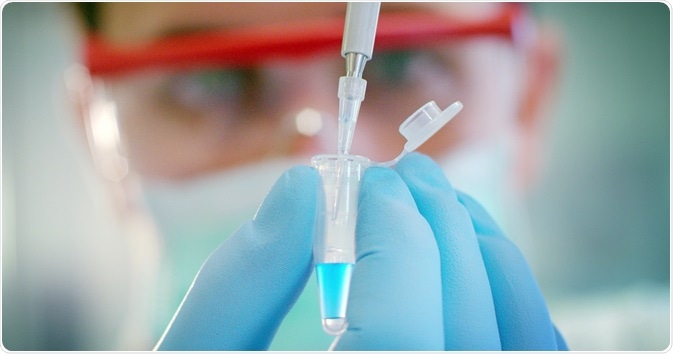Clinical chemistry, also known as clinical or medical biochemistry, is a field that focuses on the study of body fluids, such as blood, urine, and cerebrospinal fluid, for diagnostic and therapeutic purposes. Combining metabolomics with clinical chemistry allows for powerful analyses of the human body.
 Image Credit: HQuality / Shutterstock
Image Credit: HQuality / Shutterstock
Being closer to physiological or pathophysiological phenotypes, metabolomics provides extra benefits over other important analytical platforms, including genomics and proteomics. Thus, the importance of metabolomics in clinical chemistry is obvious.
Although the application of metabolomics started ‘unknowingly’ in the 1960s, it was only in 1971 that Linus Pauling and colleagues pictured the core idea of modern metabolomics, which hypothesized that information-rich data portraying the “functional status of a complex biological system” could be found in the quantitative and qualitative pattern of metabolites in body fluids.
Current applications of metabolomics in clinical chemistry
Metabolomics includes two important platforms: analytical techniques, such as mass spectrometry and nuclear magnetic resonance, and multivariate data analysis techniques. As such, data obtained through metabolomics are very useful in clinical chemistry in terms of discovering new biomarkers or providing information on existing biomarkers that are related to specific diseases.
Nanotechnology, predictive medicine, neutraceuticals, and regenerative medicines are considered as the prospects of clinical chemistry and transfusion medicine. Metabolomics has its influences in all these fields.
In nanotechnology, metabolomics can be applied for nanoseparation, biomarker discovery, and biosensor development to detect biomarkers.
In predictive medicine, a field that involves predicting the probability of disease and developing preventive measures, higher specificity and sensitivity of metabolomics can lead to early and accurate disease diagnosis.
Such early diagnosis subsequently leads to the development of effective and low cost therapeutic approaches, which is particularly important in patients with life-threatening diseases as well as in the elderly population.
Neutraceuticals are the bioactive compounds in foods that hold an important position in food chemistry in terms of deciding health benefits of edible substances. Neutraceuticals are also considered as compounds with great preventive values against many diseases.
For example, a balanced diet is pivotal in preventing diabetes, or at least delaying its onset. Metabolomics helps in identifying these important neutraceuticals, selecting appropriate doses, evaluating molecular mechanisms, and designing and validating neutraceuticals-enriched products.
In the field of regenerative medicine, which includes replacement or regeneration of human cells, tissues, or organs to regain their physiological functions, metabolomics is considered a significant tool for assessing disease phenotypes and evaluating and selecting correct stem cells for transplantation.
Studies involving metabolomics and clinical chemistry
Recent neonatal studies have recognized metabolomics as an important tool in clinical chemistry to develop personalized neonatal medicines. The findings of these studies indicate that metabolomic analyses of urine samples collected from preterm and full-term infants may provide distinct metabolic patterns related to different gestational stages. Such information might be very useful in terms of managing various disorders associated with pre-term births.
Targeted metabolomics, a field that involves studying a predetermined set of metabolites based on their relevance in physiological or pathophysiological conditions, is a new strategy in clinical chemistry that is projected to have great diagnostic potential.
It's capacity to reveal actual physiological and pathophysiological conditions makes metabolomics a superior tool in comparison to conventional diagnostic techniques, such as enzyme assays, immunoassays, and molecular diagnostics, which only and mainly detect risk factors.
Taken together, metabolomics emerges as a powerful and promising tool in clinical chemistry in screening disease-related biomarkers, discovering new biomarkers as early predictors of disease outcome, and diagnosing and monitoring various diseases to ensure effective management.
Sources:
- D’Alessandro, A., Giardina, B., Gevi, F., Timperio, A. M., & Zolla, L. (2012). Clinical Metabolomics: the next stage of clinical biochemistry. Blood Transfusion, 10(Suppl 2), s19–s24.
- Weinberger, KM & Breit, M. (2016). Targeted Metabolomics: The Next Generation of Clinical Chemistry! Application of Clinical Bioinformatics, 11, 175-211.
- Antonucci et al. (2010). Metabolomics: the "new clinical chemistry" for personalized neonatal medicine. Minerva Pediatrica, 62(3 Suppl 1), 145-8.
- Pauling, L., Robinson, A. B., Teranishi, R., & Cary, P. (1971). Quantitative Analysis of Urine Vapor and Breath by Gas-Liquid Partition Chromatography. Proceedings of the National Academy of Sciences of the United States of America, 68(10), 2374–2376.
Further Reading
Last Updated: Aug 23, 2018